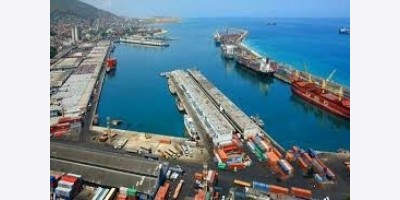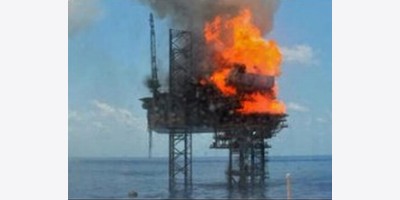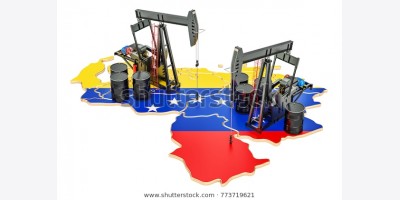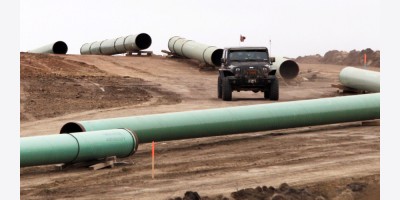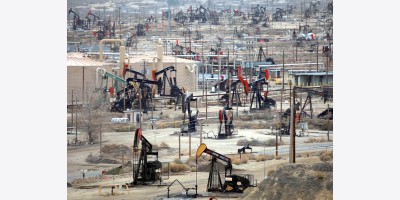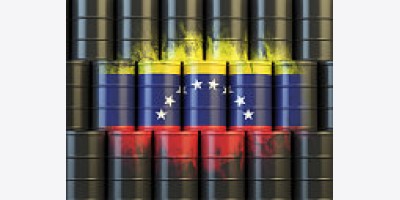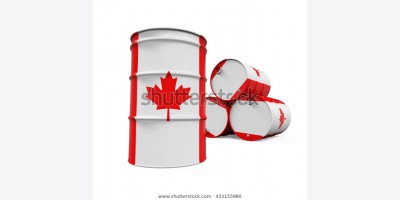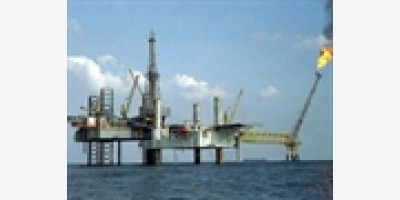Libya Government Planning Own Oil Export Program to Weaken Rival
(Bloomberg) -- Libya’s internationally-recognized government asked companies buying oil from ports under its control to deal with its administration, a move seen as an effort to weaken a rival, Islamist-backed cabinet.
Al Mabrook Bu Seif, the chairman of National Oil Corp. appointed by the elected government, said his management team is drafting a loading program that is separate from the one implemented so far, which was designed by another management team of the state-run company based in the capital, Tripoli.
“We will ask in a week or two the NOC clients to apply for the new loading program that covers the ports under control of the legal government,” he said in a telephone interview late Tuesday from the eastern export terminal of Ras Lanuf.
The North African nation has been divided between two administrations since July, when the Libya Dawn coalition of Islamist militias captured Tripoli, forcing the government and parliament that elected it to move to eastern cities of Al-Bayda and Tobruk respectively. Libya Dawn set up a rival cabinet in the capital, where NOC has its headquarters.
“From an energy perspective, it reinforces Tobruk’s attempts to take over the oil infrastructure, or what remains of it, and gain access to its revenues,” said Riccardo Fabiani, North Africa analyst at Eurasia Group. It provides “a further incentive to Libya Dawn to seize part of it or disrupt production at least,” he said.
The eastern-based government on Tuesday asked companies to deal with the administration of Bu Seif, whose appointment was announced in November to replace Mustafa Sanalla, who continues to chair the company in Tripoli with the approval of the Islamist-backed government.
Important Decision
“We have to wait and see if they actually follow through their threat, but it’s a potentially important decision with ramifications in the energy as well as political spheres,” Fabiani said in an e-mail on Tuesday.
The infighting caused Libya’s output to drop to 220,000 barrels a day last month, according to data compiled by Bloomberg. The country, which has become the smallest producer of the Organization of Petroleum Exporting Countries, pumped about 1.6 million barrels a day before the 2011 rebellion that ended Muammar Qaddafi’s 42-year rule.
The internationally-recognized government of Abdullah al-Thinni controls five of Libya’s nine oil export terminals, while the Islamist-backed government of Omar al-Hassi controls two. The remaining two are offshore platforms.
“The NOC under the control of Hassi’s government will bear the responsibility of any split as it is not following the instructions of the legal government,” said Bu Seif.
“From a political point of view, it’s a further obstacle to peace, because the Islamists will see this as a demonstration that Tobruk is not serious about the negotiations and they are proceeding unilaterally,” Fabiani said, referring to UN-sponsored talks to bring about a national unity government.
Oil Sinks on Supply Outlook; Dollar Holds Drop Before Fed
(Bloomberg) -- Oil extended losses from a six-year low with U.S. government data projected to show crude stockpiles rose to a fresh record. Asian stocks swung, while the dollar held declines before the Federal Reserve reports on policy.
West Texas Intermediate crude slid a seventh day, dropping 2 percent to $42.59 a barrel by 9:55 a.m. in Tokyo. The MSCI Asia Pacific Index fluctuated between gains and losses as Japan’s Topix index climbed 0.2 percent, while Fortescue Metals Group Ltd. dragged down the S&P/ASX 200 Index in Sydney. U.S. stock futures were little changed after the Standard & Poor’s 500 index lost 0.3 percent. The greenback maintained a two-day drop versus the euro and lost 0.3 percent to the Korean won.
U.S. oil is on the cusp of a bear market with analysts predicting data from the Energy Information Administration Wednesday will show supplies already at their highest level in more than 30 years rose by another 4.4 million barrels. The Fed may cut a reference to being “patient” on rate rises in its policy statement, Morgan Stanley and BNP Paribas SA say. In Asia, China posts property prices Wednesday, and Malaysia is projected to report a slowdown in consumer-price growth.
“The ongoing deterioration in the supply-demand picture continues without any sign of interruption,” Michael McCarthy, a chief strategist at CMC Markets in Sydney, said by phone. “With concerns about the demand-side of the equation, it looks like we’re heading toward $40 in the next couple of sessions.”
Industry Data
West Texas Intermediate crude has dropped 15 percent over the past seven days, and is down about 20 percent from this year’s peak, meeting some investors definition of a bear market. Figures from the industry-funded American Petroleum Institute indicated supplies rose by 10.5 million barrels last week. Brent oil futures fell 0.6 percent to $53.21 a barrel after rising 0.1 percent on Tuesday.
The Topix climbed to its highest level since November 2007, while the Kospi index in Seoul added 0.2 percent and New Zealand stocks fell 0.6 percent.
The S&P/ASX 200 dropped 0.3 percent as Fortescue sank to its lowest level since January 2009. The world’s No. 4 iron ore exporter pulled plans to refinance some of its debt with a $2.5 billion bond, citing volatile U.S. credit markets and a failure to achieve the terms that it wanted. Fortescue planned to use proceeds from the issue to refinance some of its debt. Iron ore, Australia’s biggest export, sank 3.3 percent Tuesday in Qingdao, China, to a record-low $56.95 a dry metric ton.
Markets ‘Nervous’
The Bloomberg Dollar Spot Index, which tracks the greenback against 10 major peers, was little changed for a second day after sinking 0.5 percent from a decade high on Monday. The euro was steady at $1.0604 after rebounding from a 12-year low the past two days, while the won climbed to 1,127.02 per dollar. Yields on 10-year Treasury notes were little changed at 2.05 percent after falling for a third day in New York.
“Markets are a bit nervous ahead of the meeting,” Shane Oliver, global strategist at AMP Capital Investors Ltd. in Sydney, said by phone, referring to gathering of the Fed’s Open Market Committee. “It’s possible that the market will be left none the wiser about whether the first rate hike will come in June or September, but we are undoubtedly getting closer.”
The Fed is likely to cut the reference to patience, a move that may open the door to a U.S. rate increase as early as June, Oliver said. Futures trading in the U.S. showed a 54 percent chance the Fed will raise its benchmark rate to at least 0.5 percent by September, according to data compiled by Bloomberg. That was down from 56 percent odds a week ago.
Kiwi Weaker
The New Zealand dollar was steady at 73.06 U.S. cents after slipping 0.9 PERCENT Tuesday after the price of whole milk powder at GlobalDairyTrade’s fortnightly auction fell for the second time in a row. The declines damp prospects Auckland-based Fonterra Cooperative Group Ltd., the world’s largest dairy exporter, will be able to raise its 2015-2016 farmer payout to NZ$6 per kilogram, according to ANZ Bank New Zealand Ltd.
The S&P 500 fell as much as 0.8 percent Tuesday, after rallying the day before by the most since Feb. 3 amid data showing an unexpected drop in factory production and a retreat in confidence among U.S. homebuilders. A report Tuesday indicated housing starts plunged in February, while an increase in building permits indicated the drop may prove temporary.
To contact the editors responsible for this story: Emma O’Brien at eobrien6@bloomberg.net John McCluskey
Help as Investment Slumps
(Bloomberg) -- The North Sea, which brought upheaval to global oil markets in the 1980s just as shale has in this decade, is desperately seeking tax relief in Wednesday’s British budget.
As international oil prices continue their downward spiral, North Sea producers are among the biggest victims. Production is less than half its peak in the 1990s and a quarter to a third of its U.K. fields are uneconomic at current prices, BP Plc Chief Executive Officer Bob Dudley said in February.
Royal Dutch Shell Plc, Europe’s largest oil company and a pioneer in developing the North Sea, signaled the region was entering its twilight when it announced last month it was planning to dismantle one of its four Brent platforms.
Brent, one of the largest fields discovered in the North Sea, which has produced about 4 billion barrels since 1976, gives its name to the grade of oil that provides the price benchmark for two-thirds of the world’s crude.
“If things stay as they are, the short- to medium-term outlook for the North Sea, in terms of maximizing the recovery of the U.K.’s oil and gas resources, will remain negative,” London-based broker Peel Hunt LLP said in a note to clients.
The industry is counting on Chancellor of the Exchequer George Osborne to help with tax cuts on Wednesday when he delivers the government’s last budget before May’s general election. The group that represents oil and gas companies wants the tax on North Sea profits cut and a simpler and more generous tax break for investment.
Vital Changes
“Tax changes are vital,” Malcolm Webb, CEO of lobby group Oil & Gas UK, said in a statement on Monday. Action “is urgently needed in order to help re-establish the competitiveness of the U.K. oil and gas industry.”
Investment in the North Sea is on the verge of collapse with oil futures in New York dipping below $43, its lowest level in six years. The area is already beset by sky-high costs, rapidly depleting fields and uncertainty about who pays to decommission old platforms.
Production costs mixed with the tax burden meant cash flows for North Sea operators were a negative 5.3 billion pounds ($7.8 billion) last year, Webb said.
As oil continues to test new lows, companies are lining up to sell assets, only to find there are no buyers.
BG Group
BG Group Plc, Apache Corp. and Marathon Oil Corp. are among companies that have explored a sale of their North Sea assets. The Financial Times reported Russian billionaire Mikhail Fridman is preparing to sell a dozen gas fields in the North Sea to avoid problems that would prevent LetterOne Group from buying RWE AG’s Dea.
In total, assets worth as much as 20 billion pounds are currently for sale in the North Sea, according to investment bank Evercore Partners Inc.
The North Sea as victim of low oil prices marks a sharp contrast from its glory days. In the oil rout of the 1980s, when new oil coming onto the market also prompted the Saudis to hold the line on their own production, the North Sea, Alaska and several smaller new entrants, were responsible for upsetting the established balance in the market.
Now weakened by time, the North Sea operators will be raptly watching Osborne’s budget. Oil producers pay a total of 60 percent tax on profits: a supplementary levy of 30 percent in addition to the regular corporation tax at 30 percent.
In December, the government announced several measures to encourage North Sea investment, including reducing the supplementary tax to 30 percent from 32 percent on producers and adding incentives to carry out seismic surveys in under-explored areas. Last month, Osborne promised to take further action to help the North Sea after oil prices fell by more than half in less than six months.
“It’s offshore and a harsh operating environment,” said Jason Gammel, an analyst at Jefferies LLC in London. “You can see operating expenses at particular fields as high as $50 a barrel, clearly not generating much profit in the the current oil price environment.”
Citi Sees Slower Commodities Demand Growth as China Recedes
(Bloomberg) -- Global commodity markets will see slower and less synchronized demand growth from across the world as China’s dominance fades, according to Citigroup Inc.
Global demand expansion, which centered on the rise of China in the 2000s, will slow in the next decade and be driven increasingly by India, Southeast Asia, the Middle East, Latin America and Africa, the New York-based bank said in a report e-mailed Tuesday. While demand will increase from these regions, dubbed the “Emerging 5”, it won’t be enough to offset the impact of slower growth from China, Citigroup said.
Commodities tumbled to a 12-year low on Monday, with crude oil in New York slumping 18 percent in 2015. Inventories are rising after a decade-long bull market spurred farmers, miners and drillers to increase production just as economic growth slowed in China. The world’s biggest metals and energy consumer grew at the slowest pace since 1990 last year.
“China’s economic transition and the inability of other emerging markets to pick up the slack are driving slower demand growth across the commodities complex,” analysts including Ivan Szpakowski and Ed Morse wrote in the report. “The extent of slowdown is likely to vary by commodity.”
The Bloomberg Commodity Index, which tracks 22 raw materials, was at 97.4738 on Tuesday, down 6.6 percent this year. The gauge slumped to 96.4714 on Monday, the lowest level since June 2002.
Hard Hit
Among the hardest hit raw materials from China’s slowdown are bulk commodities such as coal, iron ore and steel due to their exposure to China’s manufacturing, infrastructure and real estate sectors, according to the report.
Oil consumption growth in China and the Emerging 5 will slow to 2.7 percent in 2014-2020 and 2.3 percent in 2020-2025 from 4 percent in 2001-2011. Emerging market demand for base metals will expand about 3 percent to 5 percent into the 2020s, while wheat consumption may rise about 0.9 percent annually from 2014 to 2020, the bank estimates.
The Middle East will probably be the top source of oil and gas consumption growth, while India will be the top driver for coal, it said. For steel, demand growth will be about equally spread across the Middle East, Southeast Asia, India and China.
Only in base metals China’s predominance may remain unchallenged, with the country accounting for about half of global demand. The gap between it and the ‘Emerging 5’ will shrink significantly, Citigroup said.
“Global demand as a whole should become less cyclical as a downturn in one key economy has a lesser impact on overall demand,” the analysts wrote. “In other words, commodities demand should be more stable.”
(Bloomberg) -- Oil fell to a six-year low on speculation that U.S. crude inventories climbed from the highest in more than three decades.
Crude supplies rose 4.4 million barrels last week, according to a Bloomberg survey before an Energy Information Administration report on Wednesday. April oil in New York rebounded from the session’s lows and the spread between it and contracts for later delivery narrowed because of the expiration of front-month options Tuesday, said Tim Evans, an energy analyst at Citi Futures Perspective in New York.
U.S. output has risen to the highest in three decades even as oil explorers idle an unprecedented number of drilling rigs. Price swings in crude will ease in the second half of the year and U.S. production will probably start contracting by December, Vitol Group’s chief executive officer said, predicting no return to $100 a barrel within three years.
“We’re going to continue to see stock builds in the U.S. for a while,” Katherine Spector, a commodities strategist at CIBC World Markets Inc. in New York, said by phone. “There shouldn’t be an improvement in the global supply-demand balance until the second half of the year.”
Bear Market
West Texas Intermediate for April delivery fell 42 cents, or 1 percent, to settle at $43.46 a barrel on the New York Mercantile Exchange. It’s the lowest close since March 11, 2009. A settlement at $42.82 or lower would be 20 percent below this year’s peak, meeting a common definition of a bear market. May crude dropped 94 cents, or 2 percent, to $45.19. The volume of all futures traded was 18 percent above the 100-day average at 2:50 p.m.
Prices for WTI dropped from the settlement after the American Petroleum Institute was said to report a U.S. inventory gain. Stockpiles rose 10.5 million barrels last week, the API said, according to reports on Twitter. WTI slipped $1.17 to $42.71 in electronic trading at 4:38 p.m.
Brent for May settlement slipped 43 cents, or 0.8 percent, to $53.51 a barrel on the London-based ICE Futures Europe exchange. The April contract expired Monday. Volume was down 2.1 percent from the 100-day average. The European benchmark crude closed at an $8.32 premium to the May WTI.
The CBOE Crude Oil Volatility Index, which measures price fluctuations using options on the U.S. Oil Fund, climbed to 59.08, about three times what it was a year earlier. Higher volatility increases the likelihood of swinging in and out of bull and bear markets, and making those markers less meaningful.
U.S. crude inventories climbed to 448.9 million barrels on March 6, the highest in weekly EIA records dating back to August 1982. Production accelerated to 9.37 million barrels a day, the most since at least January 1983, according to the Energy Department’s statistical arm.
Falling Rigs
“Even with the rig count down by nearly half there’s no sign that supplies are abating,” John Kilduff, a partner at Again Capital LLC, a New York-based hedge fund that focuses on energy, said by phone. “There’s been no production response to the fall in prices yet, either from U.S. producers or OPEC. We’ll need to see one for prices to rebound.”
It’s uneconomic for some U.S. companies to operate at current prices and supply will eventually be cut, said Ian Taylor, CEO of Vitol, the world’s largest independent oil trader. The market remains oversupplied and prices may weaken further until that supply slowdown takes place, he said.
“The market will come to balance by the second half of the year and we should see prices steady up and maybe go up a bit from there,” Taylor said at a conference in Cape Town Tuesday.
Iran Exports
Iran could increase exports by 1 million barrels a day if international sanctions were lifted, Oil Minister Bijan Namdar Zanganeh said as talks resumed over its nuclear program. World powers are negotiating with Iran on an agreement ending a decade-long dispute over its nuclear program. Diplomats from the U.S. and Iran, working toward an end of March deadline, resumed talks on Monday in Lausanne, Switzerland.
“If an agreement is reached Iran could add another million barrels a day to the market, not to mention all the oil they have in storage,” Kilduff said. “There are also signs that Libyan production is rebounding.”
Libyan output is near 490,000 barrels a day after the restart of the Elephant and Wafa fields, the Libya News Agency reported. That’s more than double February’s average, according to data compiled by Bloomberg. The country has managed to restore some production despite clashes between its Tobruk-based government and their Islamist rivals, who control the capital in Tripoli.
Gasoline, Distillate
Saudi Arabia’s plans to expand local refineries while maintaining its share of the global crude market point to higher output, according to analysts at Societe Generale SA and DNB ASA. The biggest producer in the Organization of Petroleum Exporting Countries may pump as much as 10 million barrels a day by April, according to Torbjoern Kjus, an analyst at DNB in Oslo. That would be the most in more than two years, according to Bloomberg data.
U.S. supplies of gasoline and distillate fuel, a category that includes diesel and heating oil, probably fell in the week ended March 13, according to analysts surveyed by Bloomberg.
Gasoline futures for April delivery rose 0.15 cent to settle at $1.7301 a gallon. April ultra low sulfur diesel slipped 0.47 cent, or 0.3 percent, to $1.6939, the lowest close since Jan. 30.
Regular gasoline at U.S. pumps is following futures lower. The average retail price slipped 0.9 cent to $2.415 a gallon Monday, according to AAA, the nation’s biggest motoring group.
Vitol Sees Oil-Price Stability, Contracting U.S. Production
(Bloomberg) -- Price swings in crude oil will ease in the second half of the year and U.S. production will probably start contracting by December, Vitol Group’s chief executive officer said, predicting no return to $100 a barrel within three years.
It’s uneconomic for some U.S. companies to continue operating at current prices and supply will eventually be cut, Ian Taylor, CEO of the world’s largest independent oil trader, said at a conference in Cape Town Tuesday. The market remains oversupplied and prices may weaken further until that supply slowdown takes place, he said.
“We are all trying to work out when does the incremental U.S. production begin to disappear,” Taylor said. “We believe the market will come to balance by the second half of the year and we should see prices steady up and maybe go up a bit from there.”
Crude’s rebound from the lowest level in almost six years has faltered amid speculation that a surplus may expand. U.S. production and stockpiles continue to rise from the highest level in three decades, even after last year’s price slump of almost 50 percent. Cutbacks in oil-drilling rigs in the U.S. have so far failed to slow output growth, the International Energy Agency said in a report March 13.
Rig Count
Rigs targeting oil in the U.S. fell by 56 to 866, Baker Hughes Inc. said on its website on March 13, the lowest level since March 25, 2011. That will equate to annual production growth of 230,000 barrels a day by the fourth quarter, Goldman Sachs Group Inc. said in a report on March 15.
“With the huge drop in rig counts, it would be very odd if we didn’t see production beginning to tail off in terms of its growth in the second half,” Taylor said in an interview after speaking. “At the moment, we continue to see good supply and as yet American production particularly continues to be still growing. There is potential for prices to still drop further.”
Oil will “probably not in the next three years” return to $100 a barrel, Taylor said. “I wouldn’t rule it out at some stage.”
Vitol is seeking to hedge refining margins in the second half of the year, which could be a difficult period for companies processing crude, Taylor said.
U.S. crude production increased to 9.37 million a day in the week to March 6, the fastest pace since at least January 1983, according to the Energy Department’s statistical arm. The country’s output will start to drop by the end of the year, Taylor said.
Vitol’s revenues fell 12 percent in 2014 due to the plunge in the oil price, the company said in a statement March 12. In a “demanding year” of highly volatile markets, revenue fell to $270 billion from $307 billion in 2013. Brent crude dropped 48 percent last year, the biggest annual decline since 2008.
US crude settles at $43.46 a barrel, lowest since March 2009
Oil prices closed lower Tuesday on expectations of a 10th week of record builds in U.S. crude, although a weaker dollar limited the market's downside.
Traders and investors have forecast that crude stocks in the United States rose last week to above 452 million barrels, a Reuters poll showed. That would be the biggest domestic stockpile in at least 80 years.
The American Petroleum Institute, an industry group, will issue its weekly inventory report at 4:30 p.m. EDT (2030 GMT), two hours after the market's close and ahead of Wednesday's official data from the U.S. Energy Information Administration.
Also pressuring prices was rising output in Libya and Iran's eagerness to export more oil once it clinches a nuclear deal removing Western sanctions, traders said.
The slide in crude prices was limited by a weaker dollar that made commodities denominated in the greenback more appealing to holders of other currencies. The dollar paused on Tuesday in its march toward parity with euro, weakening almost half a percent against the single currency.
Position squaring ahead of the expiry of options in U.S. crude added volatility to the market.
"You're getting a little crazy action today because options are expiring," said Tariq Zahir, managing partner at Tyche Capital Advisors in Laurel Hollow in New York.
U.S. crude, or West Texas Intermediate, settled down 42 cents, at $43.46 a barrel, the lowest since March 2009.
Brent oil slipped almost 50 cents to $53.50 a barrel.
Brent last closed higher on March 11. Since then it has lost more than 7 percent, and traders believe it will break below $50.
"OPEC members are still staunchly producing...and demand from Europe and China are really struggling to pick up," said Kash Kamal, senior research analyst with Sucden Financial. "The overall tone is quite bearish."
Kamal said any suggestion from the U.S. Federal Reserve, which will begin their two-day meeting later today, that they are moving toward their first interest rate rise in a decade could underpin crude prices, as it would suggest optimism from the Fed on the U.S. economy.
Others also see the possibility for markets to stabilise or even rise, with Vitol Chief Executive Ian Taylor telling a conference on Tuesday that oil markets would "come into balance" by the second half of the year.
However the potential of a nuclear deal that could end sanctions against Iran, allowing Tehran to send more of its oil into the market, also dragged on oil markets.
Commerzbank said that if an agreement is reached, up to 1 million barrels per day of additional oil from Iran could reach the market in the second half of the year.
"When people look at the market now, they are looking at the possibility of an Iran resolution," Bjarne Schieldrop, chief commodities analyst with SEB in Oslo.
Oil touches six-year low as Iran talks weigh
Fears of a supply glut popped a rebound in the price of oil on Tuesday, with comments from Iran about higher production and a possible lifting of sanctions piling on further pressure.
West Texas Intermediate (WTI) futures fell as low as $42.63 a barrel—their weakest level since the March 2009 nadir of $42.51—before paring some losses.
Brent crude futures hovered near six-year lows below $53 a barrel, before also paring some losses.
Amrita Sen, chief oil analyst at energy research consultancy Energy Aspects, told CNBC that she expected prices to go lower in the short-term, with Brent dropping to the high $40 level and WTI breaking below the $40 mark.
"It's (trading) positioning and the U.S. dollar that is accentuating the downtrend, for sure," the London-based analyst told CNBC Tuesday.
"This is seasonality as well, we forget, its March, April. This is exactly when oil falls every single year. Sure, we usually come off from $110 down to $90, but this is the time when refineries go into maintenance."
WTI prices have dropped around 60 percent since mid-June last year, and are around 18 percent below the rebound seen in the middle of February, when futures pushed back up to around $53 a barrel.
'Unduly bearish'
Oil prices are also under pressure because of signs that Iran could move to boost its oil production. On Monday, Iran's oil minister said the country was ready to step up production by 1 million barrels per day if international sanctions were lifted, according to IRNA news agency.
U.S. Secretary of State John Kerry was locked in talks on Tuesday with his Iranian counterpart in the Swiss city of Lausanne. Also on Tuesday, Iranian President Hassan Rouhani said that the country was already producing more oil, despite the sanctions, according to Reuters.
Kevin Book, research team head at ClearView Energy Partners, told CNBC on Tuesday that a deal with Iran was "more likely than not" and that Tuesday's oil price move "might be actually unduly bearish."
Washington D.C.-based Book said there was a more than a 50 percent chance of Iran being welcomed back into the international community, but that it would be through a series of "gates and steps" that could take time.
In a note on Tuesday morning, Barclays analysts Rahul Bajoria and Fabrice Montagne concurred that sanctions would not be removed in "one fell swoop."
'Significant oversupply'
Sen said oil markets were heading into a period of "significant oversupply," and with the dollar rising, she expected all commodities, including oil, to come under more pressure.
However, she added that it was market speculation and large exchange-traded funds that could have a bigger effect on the price. $92 million barrels of oil are consumed daily, but trillions of dollars of oil is traded every day, according to Sen.
"In the grand scheme of things we are oversupplied by 1 percent, if that. There has been an overreaction as well," she said.
More optimistic voices in the oil industry suggest that prices could regain some strength later in the year.
At an oil conference in Cape Town, Ian Taylor, the CEO of oil trader Vitol, said that markets would "come into balance" by the second half of the year, according to Reuters.
"We should be able to see prices steady up, maybe go up a bit from there," he said on Tuesday, according to the news agency.
Matt ClinchAssistant Producer, CNBC.com
Iran oil supply concerns are 'unduly bearish': Analyst
Concerns that a nuclear deal with Iran could end sanctions on that country and flood an oversupplied market with oil are "unduly bearish," the managing director at Clearview Energy Partners said Tuesday.
"The deal they have probably won't bring back crude exports to their full level right away," Kevin Book said in an interview on CNBC's "Squawk Box." "It's probably going to be a series of gates and steps, a process where Iran has to do some things, the West will give some sanctions relief."
Oil prices began another leg downward last week as participants in negotiations over Iran's nuclear program suggested they are making progress toward a deal. The April contract for U.S. crude touched a six-year low below $43 on Monday after prices rebounded slightly in January and February.
The first steps will unlikely roll back sanctions enforced in 2012, he said. Those include a European Union import ban on Iran's petroleum exports, as well as measures that target insurance and transportation companies connected to its oil sector.
"That's one of the hardest things to restore if they do, so it might be six or 12 months out before you get that 300,000 to 500,000 barrels per day," Book said.
Some energy experts believe Iran could ramp up exports to 500,000 to 800,000 within half a year, Reuters reported Tuesday.
The U.S. Energy Information Administration estimates that net exports of Iranian oil have fallen from about 2.4 million barrels per day in 2011 to about 1 million.
If the United States and United Nations allows more foreign investment to flow into the country while export sanctions are being removed, Tehran will have more potential, Book said.
Congress is currently considering two pieces of legislation that could derail an agreement, one that would impose further sanctions on Iran and one that would subject any deal to end sanctions to congressional review.
Book said either bill would need a veto-proof majority in Congress, and that does not look likely.
"You might be able to pass a bill, but when the president vetoes it, the question will be where do Democrats stand? They're probably not all going to stand with the Republicans," Book said.
U.S.: Security risks in oil-rich Saudi region
RIYADH, Saudi Arabia, March 17 (UPI) --RIYADH, Saudi Arabia, March 17 (UPI) -- U.S. consular services in Saudi Arabia remain closed five days after a threat surfaced against Western oil workers in the country, the U.S. embassy said.
The U.S. Embassy in Riyadh said consular services are suspended through Tuesday because of unspecified heightened security concerns at diplomatic outposts in Saudi Arabia.
"A new security message will be sent out as soon as consular services return to normal," an embassy statement read.
An embassy statement last week was specific to Western oil workers. The embassy said Friday it had information stating that terrorist groups may have plans to target oil workers, "possibly to include those U.S. citizens working for oil companies in the Eastern Province [of Saudi Arabia], for an attack and/or kidnapping."
The embassy provided no further information on methods, groups or timing of the attacks. The Saudi Interior Ministry in 2011 vowed to use "an iron fist" when violence in the Shiite-dominated Eastern province, the center of the kingdom's oil industry, erupted.
Flare-ups in violence in the past have involved disgruntled minority Shiites, who number around 2 million in the overwhelmingly Sunni kingdom. Riyadh's concerns in 2011 coincided with the start of the Arab Spring.
A February warning from the U.S. State Department said there may be risks to U.S. citizens traveling to Saudi Arabia. Westerners and Shiites were attacked in Eastern province in November.
The embassy warning follows a government takeover in Yemen by the Houthi movement, a Shiite group, and lingering regional threats from the group calling itself the Islamic State. Militants tied to the Islamic State in Libya were allegedly behind the abduction of four Filipino nationals earlier this month.
© 2015 United Press International, Inc. All Rights Reserved.
Iran reports economic growth momentum
Published: March 17, 2015 at 7:16 AM
TEHRAN, March 17 (UPI) --TEHRAN, March 17 (UPI) -- The Iranian economy grew by 3.6 percent during the nine-month period that began in March 2014 despite Western sanctions, the Central Bank of Iran said.
Iran's economy emerged from recession in late 2014, though sanctions still curb the country's ability to generate revenue from oil and gas sales. The Central Bank of Iran, however, said a nine-month growth rate of 3.6 percent represents an increase in $54 billion.
Iranian budget negotiators are working on a draft for a new year that begins Saturday that envisions less dependency on oil revenue. When he wrapped up his mission to Iran last month, Martin Cerisola, assistant regional director for the International Monetary Fund, warned "the sharp drop in global oil prices and an uncertain external environment" presents significant challenges to Iran's economic future.
Sanctions on Iranian oil exports and other parts of the economy resulted in an economic contraction of 5.8 percent in 2012-13. For fiscal year 2013-14, the World Bank estimates the Iranian economy contracted at an annual rate of 1.7 percent.
Sanctions may be revised if there's a breakthrough in multilateral negotiations aimed at resolving concerns over Iran's nuclear research program. Despite the bilateral controversy over a letter by Republican members of the U.S. Congress questioning the talks, Iranian Foreign Minister Javad Zarid said five hours of talks Monday were positive.
A July report from the Central Bank of Iran blamed external and internal factors on past economic woes. Iranian President Hassan Rouhani last month claimed an economic "miracle" when announcing the inflation rate had dropped from 40 percent under his predecessor Mahmoud Ahmadinejad to around 16 percent.
© 2015 United Press International, Inc. All Rights Reserved.
Why OPEC can't kill the U.S. oil boom
By Matt Egan @mattmegan5
OPEC all but declared "mission accomplished" this week in its efforts to thwart U.S. oil production.
In a report Monday, the cartel predicted the U.S. shale oil boom could be over by the end of 2015.
The world has too much oil production at the moment, and it has caused crude oil prices to meltdown from over $100 a barrel in the summer to under $45 now -- a six-year low.
Someone needs to scale back, but OPEC, led by Saudi Arabia, has refused to make cuts in an effort to squeeze American shale producers.
OPEC is claiming an early victory by pointing to declines in the number of U.S. drilling rigs and significant cuts in big energy's spending plans as evidence the U.S. is caving.
American shale here to stay: Yet OPEC is underestimating one of the most important characteristics of shale: its incredible flexibility.
Unlike traditional producers, shale companies can easily stop pumping on completed wells when prices drop and then quickly return to them. When prices rebound, so should U.S. production, making dips in output short-lived.
"OPEC is in denial. Shale production will never go away," said Fadel Gheit, an Oppenheimer analyst who covers the energy industry.
"The beauty of shale production is you can dial it up or dial it down. You can adjust your speed depending on the traffic. But you will not get out of the road. You're still in the game," he said.
Breakeven points are falling: Not only are shale producers able to quickly adjust to the changing price, they are becoming much more efficient thanks to technological innovations.
The oil price they need to be profitable is much lower than before. The trend is likely to continue, especially as previously sky-high costs for labor and services decline substantially, Gheit said.
It's also premature to say that U.S. oil output is slowing. Last week, the International Energy Agency said U.S. oil production shows no signs of slowing.
Unlike OPEC, the International Energy Agency seems to recognize the advantages that shale companies have. That's why the IEA predicted American oil production will keep growing through 2020.

Who will blink first? Saudi Arabia has made it clear it has no desire to balance the market by pumping less oil. The supply glut could be worsened by a potential deal between the West and Iran that would lift sanctions on the country's oil industry.
U.S. oil production should finish this year at around 9.7 million barrels per day, said Tom Kloza, chief oil analyst at the Oil Price Information Service. That means this year could surpass the previous all-time record of 9.6 million set in 1970.
If oil prices get back to the $70 to $90 range, U.S. oil production could eventually climb to 10 million or 12 million barrels per day, Kloza said.
"Shale is not even on the DL (disabled list) or the taxi squad. It's waiting on the bench," he said.
Shale assets won't disappear: The Saudis seem to be betting the American shale industry will be forced to close up shop if oil stays too low for too long.
While it is true that some shale producers won't survive, it's not like their assets will just disappear. The wells will stay in the ground and be acquired by larger energy companies like ExxonMobil (XOM) and Chevron (CVX).
"It's survival of the fittest. The assets will transfer to another oil company with deeper pockets and a greater resilience to lower oil prices," Gheit said.
Oil Crashes A Second Time - What’s Next?
By Evan Kelly
The double dip looks to be on. After nearly two months of moderate price gains for crude oil, by mid-March oil is swooning once again. Brent is showing a bit of resilience, but the WTI benchmark – which is the major marker for North American crude – dropped to its lowest level in six years. Producers may have thought they were nearly out of the woods, but stubborn levels of production from U.S. shale fields have prevented a rally. Even worse (for drillers) is the fact that oil storage tanks are starting to fill up. Storage at Cushing, Oklahoma is two-thirds full, and hedge funds and major investors are selling off oil contracts, betting that prices are heading south.
While the oil storage story is real – average storage levels nationwide are up to 60%, a big jump from the 48% seen a year ago – it may have been played up too much in the media. Many refineries are taken offline in the spring for maintenance, which forces drillers to pump crude into storage for several weeks. Additionally, U.S. consumers are starting to use more gasoline because of low prices, and the extra demand may soak up some of the glut. Finally, production, stubborn as it is, may soon finally begin to dip. Fresh data from North Dakota shows that may already be happening. In other words, the weekly storage build may be unsustainably high.
Nevertheless, the selloff is underway. That is providing an interesting opportunity for the U.S. government, which is set to purchase 5 million barrels for the strategic petroleum reserve (SPR). In March 2014, the U.S. government sold off 5 million barrels ostensibly for a “test sale,” but was no doubt at least in part motivated by the fact that oil prices surpassed $100 per barrel. However, by law, the U.S. Department of Energy is required to replenish that sale within 12 months. With the deadline approaching, the DOE has announced plans to buy up 5 million barrels to put back into the SPR. The U.S. taxpayer is about to benefit from extraordinary timing. With prices now half of what they were 12 months ago, the government will be able to bring the SPR back to up to its proper level at half the price.
Low oil prices are good for the government, but not so good for the oil majors. Italian oil giant Eni (NYSE: ENI) became the first of the oil multinationals to slash its dividend due to low prices and also moved to suspend its share buy-back plan. Eni announced plans to pay 0.8 euros per share rather than the 1.12 euros it paid out in 2014. The move was not taken well by investors – the company’s stock tanked by nearly 5% on the announcement. Still, CEO Claudio Descalzi put on a brave face, claiming that he was “building a more robust Eni capable of facing a period of lower oil prices.” The dividend has long been prioritized by the oil majors, needing to be protected at all costs. Many of them have opted for dramatic cuts to capital spending rather than touch their dividend policies, even if that threatens future production rates. High dividends have made major oil companies highly attractive investment vehicles, allowing companies to obtain a lower cost of capital for drilling plans. Eni has bucked the trend, arguing that it will be more resilient as a result of the dividend cut. Descalzi insists the company will “be strong” if prices remain at $60 per barrel or above. It remains to be seen how long oil prices stay depressed, and whether or not other oil majors can avoid coming to the same conclusion as Eni.
OPEC released its monthly oil market report on March 16, in which it argued that North American shale will face a contraction later this year. However, the oil cartel also saw some production declines for the month, as Libya, Iraq, and Nigeria continue to struggle with violence and low oil prices. Libya, in particular, is facing a crisis. Spain raised the prospect of a European Union embargo on Libyan oil if the country’s two political factions did not make headway on peace. Cutting off Libya’s only economic lifeline almost certainly would not bring a swift end to political impasse in Libya, but the EU is clearly becoming impatient with the ongoing violence just across the Mediterranean.
Russian President Vladimir Putin reemerged from a 10-day absence that fueled many-a-rumor – speculation ranged from a palace coup, to a secret birth of a child, even to some wondering whether the Russian President met an early demise. The Kremlin offered no explanation, but Putin appeared to be just fine. Despite his seemingly good health, the Russian economy continues to buckle under the weight of low oil prices. And that, according to Bloomberg, has Putin increasingly angry at a once close ally: Rosneft head Igor Sechin. Putin is reportedly blaming Sechin for rising debt at the state-owned oil firm, perhaps stemming from the purchase of TNK-BP in 2013. Also, Sechin’s role in borrowing billions of rubles that sent the currency plummeting in December 2014 has raised the ire of the Russian President. There are rumors that Sechin could be on his way out, but those reports are unconfirmed. Nevertheless, the fraying of the relationship suggests low oil prices are taking a toll on Putin’s inner circle.
While we often talk about oil prices, natural gas prices are also making headlines. Due to extraordinary inventory builds in 2014 in addition to new pipeline capacity, the northeastern region of the United States did not experience supply shortages. In fact, natural gas inventories are now above the five-year average, the first time in more than a year that has occurred. As a result, natural gas prices did not spike this past winter in the way they did in 2014, despite record snowfall in Boston. Now, with winter in the rear view mirror, natural gas consumption will ease a bit. Natural gas prices for the month ahead delivery dropped to $2.70 on March 16, the lowest level in three years. Low prices will slow the rise in electricity rates for much of the country, which grew at their fastest rate in six years in 2014. But low natural gas prices will also inflict extra pain on drillers, already reeling from low oil prices.
By Evan Kelly of Oilprice.com
By Nicole Friedman
U.S. oil prices slid to a fresh six-year low Tuesday on expectations that domestic crude stockpiles have risen to a record high.
Light, sweet oil for April delivery settled down 42 cents, or 1%, at $43.46 a barrel on the New York Mercantile Exchange, the lowest settlement since March 11, 2009.
Stored supplies of crude oil in the U.S. are at the highest level in about 80 years, according to the U.S. Energy Information Administration, and production continues to grow. Demand is typically restrained at this time of year as refiners process less crude while performing seasonal maintenance.
The EIA is set to release inventory data for the week ended March 13 on Wednesday, and traders expect it to show another gain in crude stockpiles.
Concerns are mounting that oil inventories could reach maximum storage capacity in some locations, which could push down crude prices by limiting the places that producers could sell their crude.
“We take very seriously the concern that’s being expressed about crude-oil containment issues,” said Alan Levine, chief executive of energy brokerage Powerhouse. “We’re anticipating that prices will test down below $40.”
Prices pared some losses throughout the day. Analysts said this was because of traders closing positions ahead of the April options-contract expiration Tuesday and taking profits after prices hit new lows Monday.
A pumpjack near storage containers in North Dakota. Stored U.S. oil supplies are the highest in 80 years. Bloomberg News. ENLARGE
A pumpjack near storage containers in North Dakota. Stored U.S. oil supplies are the highest in 80 years. Bloomberg News. Photo: Bloomberg News
Though concerns remain that crude-oil storage will hit full capacity in some regions, “the threat of a capacity issue is not in the next day or two; it’s probably more in the next month or so,” said Gene McGillian, senior analyst at Tradition Energy. After falling so far in the past few sessions, “we probably need another signal that the problems are still there and they’re getting worse to really continue to move lower.”
Analysts surveyed by The Wall Street Journal expect the EIA to report that crude supplies rose by 4.1 million barrels last week. They also expect gasoline supplies to fall by 900,000 barrels and stocks of distillates, including heating oil and diesel fuel, to fall by 500,000 barrels.
The American Petroleum Institute, an industry group, said late Tuesday that its own data for the same week showed that crude stockpiles rose by 10.5 million barrels, while gasoline supplies fell by 583,000 barrels and distillate inventories fell by 252,000 barrels, according to market participants. Prices fell in electronic trading on the news.
Traders are also waiting on the outcome of the Federal Open Market Committee meeting, which concludes Wednesday. If the Federal Reserve’s policy-making arm indicates U.S. interest rates could rise around midyear, that would likely strengthen the dollar. Oil is traded in dollars, so a stronger dollar makes oil less affordable to buyers using foreign currencies.
Brent, the global benchmark, settled down 43 cents, or 0.8%, at $53.51 a barrel on ICE Futures Europe.
Gasoline futures rose 0.15 cent, or 0.1%, to $1.7301 a gallon. Diesel futures fell 0.47 cent, or 0.3%, to $1.6939 a gallon.
Write to Nicole Friedman at nicole.friedman@wsj.com
Yeganeh Torbati, Reuters
WASHINGTON (Reuters) - A possible deal over Iran's nuclear program that would phase out economic sanctions against Tehran is unlikely to flood world markets with more oil any time soon, despite Iran's declared intention to claw back market share lost because of the curbs.
Negotiators are still working out details of the deal they aim to seal by the end of June, but it would almost certainly lift sanctions only in stages, deferring even a partial return of Iranian crude exports until at least 2016, according to market experts, former U.S. officials, and Western diplomats.
Progress in talks in Switzerland this month has contributed to a more than 10 percent slide in oil prices over the past week as some traders and analysts brace for up to 1 million barrels per day (bpd) of Iranian crude hitting markets, potentially doubling the estimated global supply surplus.
Many focus on how quickly Iran can technically resume pumping oil to pre-sanctions levels, assuming shipments could follow quickly and brushing off concerns about a diminished customer base and potentially neglected oil fields.
What oil bears may underestimate is the hurdles on the diplomatic path to Iran's return to world energy markets.
"Don't expect to open the tap on oil," one Gulf-based Western diplomat told Reuters. It is much easier to lift financial sanctions because so many components of Iran's oil trade have been targeted, the diplomat said.
To be sure, a nuclear deal could allow some Iranian oil to return to the market quickly. A Reuters analysis of industry data shows Iran has up to 12 million barrels of oil in floating storage off its shores, and it has leased a storage facility in China to ship crude to India and South Korea.
Some energy experts estimate that Iran could raise its exports by 500,000-800,000 barrels per day (bpd) within six months of sanctions being lifted, but that is likely to be a result of a gradual build-up.
“The initial market response (to a deal) is likely to be quite bearish," said Richard Mallinson, an analyst at consultancy Energy Aspects in London. "The attention is still on oversupply and there are enough people out there saying this could drive a rapid increase in Iranian volumes.”
Yet whatever emerges this year "may not be the kind of flood of oil...that some in the market are worried about," Mallinson said.
FIGHTING BACK
Tehran is keen to recover market share lost under the U.S.-led sanctions that curbed the nation's oil exports to just 1 million bpd from 2.5 million bpd in 2012.
"Under no circumstance will we reduce our global market share, even by one barrel," Iranian oil minister Bijan Zanganeh said in November.
But for Iran to sell significantly more crude and repatriate hard currency earnings, many U.S. and European restrictions on its shipping, insurance, ports, banking, and oil trade would have to be lifted or waived.
Yet because they represent the bulk of world powers' leverage over Iran, initial relief would probably be modest, said Zachary Goldman, a former policy advisor at the U.S. Treasury Department's Office of Terrorism and Financial Intelligence, where he helped develop Iran sanctions policy.
Goldman predicted the first step would be to allow Tehran to use more of its foreign currency reserves abroad, now limited to specific bilateral trade.
"It's discrete, and it doesn't involve dismantling the architecture of sanctions that has been built up painstakingly over the last five years," said Goldman, who now heads the Center on Law and Security at New York University.
Even with a nuclear deal, oil sanctions would probably effectively stay in place until early 2016, said Bob McNally, a former White House adviser under George W. Bush and now president of the Rapidan Group energy consultancy.
"I don't see why a political deal in March or April or even technical implementation in July would, from a sanctions compliance perspective, enable Iran to 'unload' its stored oil any time soon, if doing so significantly increased exports above current levels," McNally said in an email to Reuters.
Low oil prices may also limit how much Iran will want to ship abroad. Zanganeh has said that the country's oil industry could survive prices as low as $25 per barrel.
The latest price slump, however, may cause Tehran to think twice about flooding the market even if sanctions are lifted, said David Goldwyn, who served as the U.S. State Department's Special Envoy and Coordinator for International Energy Affairs from 2009 to 2011 and who now chairs the Atlantic Council's Energy Advisory Board.
"It may depend on how desperate they are for cash," he said.
Iran will also face stiff competition for its main Asian markets with fellow members of the Organization of Petroleum Exporting Countries (OPEC) such as Saudi Arabia, Kuwait and Iraq.
Kuwait and other Arab OPEC members have raised doubts whether Iran will manage to ramp up production quickly given that some of its oil fields have stayed idle because of the sanctions.
(Additional reporting by Rania El Gamal in Riyadh; Editing by Bruce Wallace and Tomasz Janowski)
This article originally appeared at Reuters. Copyright 2015. Follow Reuters on Twitter.
OPEC thinks US oil production is about to hit a wall
Alex Lawler, Reuters
(Reuters) - U.S. oil output could start to take a hit by late 2015, OPEC said on Monday, suggesting the oil price collapse will take time to impact on the shale oil boom.
In a monthly report, the Organization of the Petroleum Exporting Countries (OPEC) left its forecast for non-OPEC supply this year unchanged, but said output of U.S. tight oil, also known as shale, could be curbed.
"Tight crude producers are aware that typical oil wells in shale plays decline 60 percent annually, and that losses can only be recouped by drilling new wells," OPEC said in the report.
"As drilling subsides due to high costs and a potentially sustained low oil price, a drop in production can be expected to follow, possibly by late 2015."
In the report, OPEC left its forecast for 2015 world oil demand growth unchanged and made virtually no change to its estimate of the demand for its crude this year.
This article originally appeared at Reuters. Copyright 2015.
Saudis Claim Conspiracy Theorists, Not OPEC, To Blame For Oil Price Crash
By Nick Cunningham
A top Saudi official said on March 15 that Thomas Friedman and other conspiracy theorists are to blame for the crash in oil prices.
Rather than an oversupply and weak demand causing an imbalance in global oil markets, Dr. Ibrahim Al-Muhanna, the advisor to Saudi Arabia’s Petroleum Minister, said that excessive speculation drove the oil bust.
“The recent price fall was due largely to expectation and perception about future supply and demand... and the ever-present – and incorrect – belief in conspiracy theories,” Al-Muhanna said at the Institute of International Finance Spring Membership Meeting on March 15.
Al-Muhanna admitted that supplies were building over the course of 2014, but said that demand “remained strong” and that the price fall was unjustified given market fundamentals. After prices started to fall, the media and market analysts drove the narrative to unfounded levels.
In fact, Al-Muhanna said, in October 2014 when Saudi Arabia adjusted its price for oil heading for Asia – a conventional practice that occurs every month – western media began talking up Saudi Arabia’s “price war,” and he even singled out New York Times columnist Thomas Friedman. “Then an article by Thomas Friedman suggested Saudi Arabia’s policy – in coordination with the Obama administration – was aimed at hurting Russia by lowering the oil price. This idea was a rehash of assumptions that first reasoned the oil fall of the 1980s. All complete fantasy.”
Rather than a plot between the Saudi and U.S. governments, Saudi Arabia merely made a rational business decision. He said that officials from Saudi Arabia and Venezuela met with Mexico and Russia, which are not members of the oil cartel. They discussed the possibility of coordinating production cuts to keep prices from falling further. After Russia and Mexico balked at cutting their output levels, OPEC decided it could not move forward unilaterally with production cuts, presumably over fear of losing out on market share. As he tells it, OPEC had no other choice.
Al-Muhanna said the media’s portrayal of OPEC’s decision to leave its production quota unchanged was spun out of control. “The conspiracy theory shifted completely. From being against Russia and/or Iran, to being all about hurting US shale oil production. And others said OPEC was dead! It was like staring into a mirage. It was all nonsense but it does have an impact on the direction of the oil price.”
The Saudi advisor even said that oil prices stabilized in January and February because “conspiracy theories lost their allure.”
Thomas Friedman aside, Al-Muhanna has a point when it comes to irrational movements in the oil price. He cited the “herd mentality” that takes hold during price swings. Just as U.S. rig counts began to decline precipitously in December and January, the markets turned bullish and piled into crude oil on the belief that U.S. shale production was facing impending decline. Now that fears are taking hold within the industry that storage capacity is running short, investors are pulling out of crude, sparking a renewed fall in prices. Net-long positions in oil dropped by 2.5 percent for the week ending on March 10, the lowest level in more than two years.
Needless to say, oil markets are extremely volatile right now. The CBOE Crude Oil Volatility Index – a barometer of oil price volatility – has hit four-year highs in recent months. The price tends to swing on every new indicator that gets published, with the ultimate trajectory of oil prices for the future none the clearer.
For its part, OPEC sees U.S. shale contracting much quicker than it previously projected, with production peaking later this year. In any event, Al-Muhanna remains confident over the long-term. Swelling global population and ongoing economic growth – particularly in developing countries – will mean stable and strong demand for oil for decades to come. And that means oil prices will rise. Unless, that is, conspiracy theorists spark more instability.
By Nick Cunningham of Oilprice.com
OPEC Says US Oil Production May Decline By End Of 2015
By Andy Tully
OPEC says the rate of growth in US crude output may be reduced by half this year primarily because of a decline in drilling by cash-strapped energy companies.
The decline forecast Mar. 16 by the oil cartel comes about three years earlier than a previous outlook, in which it said it didn’t expect American production to decrease until 2018.
It also differs from a report by the International Energy Agency (IEA) that claims US production remains strong as drillers focus on their most abundant oil fields and that the end of 2015 would see only a production slowdown, not a decline.
Nevertheless, the IEA report, issued March 13, caused an immediate and noticeable drop in the average global price of oil.
Whatever happens will come too late to guide any decisions OPEC may make at its regular meeting in June. It was at its last meeting on Nov. 27 that the cartel decided not to cut overall production below 30 million barrels per day which would have helped shore up tumbling prices.
By keeping production at 3-year-old levels at the November meeting, OPEC instead sought to drive oil prices low enough to make unconventional and expensive oil production, including output from shale, unprofitable and thereby reclaim the market share that OPEC had recently lost.
In its latest monthly market report, OPEC said that a fairly rapid slowing of the growth in the output of US oil eventually would lead to “a drop in production [that] can be expected to follow, possibly by late 2015,” primarily due to the reduction of rigs in service.
Further, it said the halving of oil prices since late June 2014 “could impact marginal barrel output from unconventional sources such as tight crude,” a term for shale oil, which is tightly packed in underground shale deposits. As a result, it said, US oil production is on a path to grow by only 820,000 barrels a day in 2015, compared with 1.61 million barrels per day last year.
“Tight crude producers are aware that typical oil wells in shale plays decline 60 percent annually, and that losses can only be recouped by drilling new wells,” the market report said.
According to the OPEC report, though, none of this will happen before the cartel’s next meeting, scheduled for June 5 in Vienna. At best, the cartel’s 12 oil ministers probably will be able to do no more than estimate the effectiveness of their strategy to reclaim lost market share.
But OPEC holds no illusions that rising demand will restore the value of its oil output. Global demand for oil has been slow in the past year, primarily in China and Europe, and the Mar. 16 report forecast no change for the rest of 2015.
By Andy Tully of Oilprice.com
Middle East OPEC Oil Rig Count Jumps 14%
By Euan Mearns
As if to rub salt in the wounds of the US shale industry, Middle East OPEC oil rig count has jumped by 19 rigs to 155 units in February 2015 setting a new rig count record for the region. Since 2005 the supergiant oil fields of the region developed symptoms of mortality and increased drilling has been required to combat natural production declines in order to maintain production at static levels.

Figure 1 Middle East OPEC oil rig count for Saudi Arabia, UAE, Kuwait and Qatar. Baker Hughes is not reporting data for Iran and activity in Iraq is affected by ongoing conflict. While the rest of the world is heading for the drilling exits these four Middle East countries are preparing to expand market share. All data from Baker Hughes.

Figure 2 The International oil rig count (excluding N America) has begun to fall and this will inevitably lead to declining oil production. The decline in drilling will in fact be more pronounced than shown here since in offshore areas like the North Sea, rigs are on long-term contracts and companies are currently “stacking” these rigs. A significant part of the drilling cost is men and materials and many companies operating offshore are simply choosing to not use rigs that they have paid for.

Figure 3 US oil rig count continues to plunge and total rigs will soon reach the level of the 2009 lows. Notably gas rig count has now joined in the plunge and one is left wondering where this will leave US plans for self-sufficiency in natural gas let alone plans to export LNG. US natural gas production was still rising in December 2014, according to the most recent data I could find.
The dead cat bounce in the oil price has succumbed to gravity with both Brent and WTI down 4% on Friday. WTI is back to $45, close to its low of $44.12 reached on January 9th. If that does not hold then the industry is in for a renewed bout of extreme anxiety and pain. In yesterday’s Blowout, Roger Andrews kicked off with a story from the IEA claiming that CO2 emissions did not rise in 2014. While the IEA want to claim victory in the war against CO2 I tend to wonder if this is not symptomatic of chronic weakness in the global economy that is implicated in the precipitous fall in the oil price.
By Euan Mearns of EuanMearns.com









